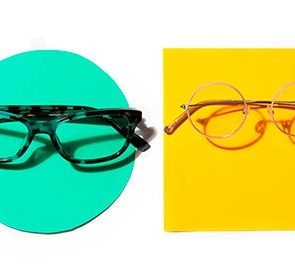5 Color Blind Glasses That May Help Correct Your Vision
Updated: Mar. 14, 2022
Do color blindness glasses really work? Check out what the experts have to say and which lenses may offer the best results.
Our editors and experts handpick every product we feature. We may earn a commission from your purchases.
Color blind glasses 101
Color blindness is a common eye condition affecting about 300 million people worldwide. But that doesn’t mean all color blind people see the world in shades of gray.
“It’s more of a color confusion,” explains Kristyna Lensky Sipes, OD, an optometrist from Stanford Ranch Optometry in California. “Often, [people with the condition] see colors differently in more of a narrow spectrum.”
What do people with color blindness see?
There are two main categories of color blindness.
“The most common form of color deficiency is red-green,” says Robert Layman, OD, president of the American Optometric Association. This is especially true for males: Roughly one in 12 men, compared with one in 200 females, has some level of red-green color blindness, according to the U.S. National Institutes of Health (NIH).
People with this condition fall into one of two camps:
- protans, who confuse greens, yellows, oranges, reds, and browns
- deutans, who have trouble telling the difference between reds, yellows, greens, and browns
Blue-yellow color blindness is much rarer, according to Dr. Layman.
People with this condition often confuse blues with greens and yellows with purples, but they may also have red-green color blindness. Unlike red-green color blindness, it affects men and women equally and occurs in about 1 in 10,000 people worldwide, per the NIH.
Why are some people color blind?
Genetics is responsible for most cases of color blindness, explains Dagny Zhu, MD, a board-certified ophthalmic surgeon at Hyperspeed LASIK in California.
It occurs thanks to a mutation in a gene on the X-chromosome that controls color vision. That’s why men are far more likely to be affected by color blindness—people born as male have only one copy of this gene.
“Because women have two X-chromosomes, a functioning gene on the second X-chromosome can make up for a mutated one,” she says.
While it’s less common, people can develop color blindness later in life, too. Dr. Zhu says that this acquired color blindness can occur due to very specific brain or eye injuries, some medications, and eye diseases like cataracts or macular degeneration.
What causes color blindness?
“Color blindness comes from a reduced sensitivity of the eye’s light receptors: the cones in the back of the eye,” Dr. Sipes says. These cones work to translate light for the brain so we can interpret which colors we see.
There are three types of cones responsible for detecting different wavelengths of light: red, green, and blue.
“Imagine the color spectrum of red, green, and blue as three hills separated by valleys,” says Ian A. Ymalay, OD, an adjunct assistant professor of optometry for the Illinois College of Optometry and Clinical Preceptor for National Vision Inc.
“Each hill represents a range of wavelengths for that particular color,” he says. But color blind people have hills that aren’t separated—instead, they overlap. That’s what causes their confusion in color detection.
What’s it like to be color blind?
Dr. Sipes says since most people with color blindness have the condition from birth, they generally learn to adapt to it independently.
“They might not see green the way you or I see green, but they still know a red apple from a green apple,” she says. “They just see it differently.”
Still, she says color blindness can complicate daily tasks or cause confusion for certain activities. As an example, she points to a kids’ soccer coach with color blindness who struggled during a specific game. On the field, the lines on the green grass were drawn in red.
“He couldn’t tell where things were in versus out,” she says.
She adds that people with color blindness may face limitations in careers requiring full-color vision, like being an electrician or pilot.
Do color blindness glasses work?
While there’s no cure for color blindness, special lenses may be able to help some people tell the difference between certain colors.
Dr. Sipes says these lenses work by filtering or blocking specific wavelengths of light. This makes it easier for someone’s faulty color cone to separate otherwise overlapping information, helping their eyes detect an object’s true color.
But there are a few caveats to how well color blindness glasses will work.
They work best in bright light
“Outdoor lenses are far more successful and far more powerful than indoor lenses as far as a ‘wow’ factor for patients,” Dr. Sipes says.
This is because brighter light allows for better wavelength separation as light passes through the glasses.
Results do vary
Dr. Zhu says it’s important to understand what type of color deficiency you have—red-green versus blue-yellow—to ensure you find the right glasses for your needs. Even then, however, there’s no guarantee they’ll work for you.
“Because of the range of [color blindness] severity, these glasses might improve color perception for some individuals while others may not notice any discernible improvement,” Dr. Ymalay explains.
They’re not a cure
Users may be able to distinguish colors that were previously muddled—so the colors “pop” more—but the glasses do not restore true color vision, Dr. Ymalay says.
This means they come with some limitations, like:
- Users won’t be able to pass a color vision test for jobs like piloting or firefighting.
- Colors are more bright and vibrant but can still be a little “off,” especially depending on the severity of someone’s color deficiency.
- They may affect the appearance of other colors.
“Typically, these glasses are good for patients who have ‘activity-specific’ needs,” Dr. Layman explains.
For example, he says people working in the maritime industry would benefit from correctly identifying red and green marker buoys when going up rivers. The glasses could also be helpful in certain situations, like shopping for new clothes, reading color-coded charts and maps, or taking medication.
Don’t wear them at night
“You need a lot of light for these [glasses] to work the way they should,” Dr. Sipes says.
She explains that using these glasses at night isn’t just less effective—it can be dangerous. Driving with them at night can cause more muddled vision and reduced contrast, making it difficult to see road signs and traffic signals properly.
They won’t work for everyone
Color blindness glasses are not effective at all for people with complete color blindness, a condition known as monochromacy or achromatopsia.
People with this form of color deficiency can only see black, white, and shades of gray. It’s pretty rare, however, affecting an estimated 1 in 30,000 people worldwide.
But they won’t work for some people with red-green or blue-yellow color blindness, either.
While in most cases of color deficiency, an individual has all three types of cones in their eyes—one just isn’t working properly—Dr. Zhu says some people are completely missing either the red, blue, or green cone. Color blindness glasses won’t help under these circumstances.
The best color blindness glasses
The first step to finding the right pair of color blindness glasses for you is a comprehensive eye exam, Dr. Layman says.
Your eye doctor can administer a simple test to determine which form of color deficiency you have, so you can choose lenses that target the right light wavelengths.
Enchroma Color Blind Glasses

Enchroma color blind glasses work to increase color contrast for people with red-green color blindness. Dr. Sipes says that among her practice’s patients, about four out of five people notice an impact in their color vision when wearing the lenses.
A 2020 study published in Current Biology found these Enchroma glasses may even help improve people’s color perception.
“They believe that through repeated physical exposure to richer color information, it’s possible to expand the visual processing center in the brain,” Dr. Sipes says. While more research is necessary, this means it might be possible for people to better identify colors over time, even without the glasses.
While Enchroma glasses are some of the most expensive on the market, the brand does offer a 60-day money-back guarantee.
Enchroma Color Blind Glasses for Kids

Enchroma also offers a line of color blind glasses designed for children.
Like their grownup counterparts, these kids’ glasses offer 100 percent UV protection and are compatible with most prescriptions. You can also choose from:
- lenses geared toward either protan or deutan red-green color blindness
- indoor or outdoor lenses
- different frame styles
And if wearing the glasses does indeed “train” our visual processing center, Dr. Sipes says this effect may be stronger in younger brains.
“We always want kids to try these on,” she says.
Pilestone Red-Green Color Blindness Glasses

Pilestone has four different types of lenses tailored to different types and severity of red-green color blindness:
- Lens A is best for people with mild to moderate deutan or protan color blindness, suitable for both indoor and outdoor activity.
- Lens B is geared toward those with strong to severe deutan or protan color blindness, also suitable for indoor or outdoor activity.
- Lens C is designed for those with mild to strong deutan color blindness—and has the added benefit of working especially well in low lighting.
- Lens D is ideal for people with protan color blindness.
This line of lenses offers similar results to Enchroma models, but they come at a more budget-friendly price. Like Enchroma, Pilestone offers a 60-day return period.
Pilestone Red-Green Color Blindness Clip-ons

While you can add a prescription to Pilestone’s standard color blindness glasses, the brand also offers low-profile clip-on lenses that fit seamlessly over the top of your everyday eyeglasses.
These clip-ons also bring 100 percent UV protection and are available for mild to severe deutan and protan color blindness.
Pilestone Blue-Yellow Color Blindness Glasses

This pair of color blindness glasses from Pilestone is one of the only options available for people with blue-yellow color blindness, or tritan color blindness, a rarer form of color deficiency. The brand’s blue-yellow lenses are for both indoor and outdoor use.


















